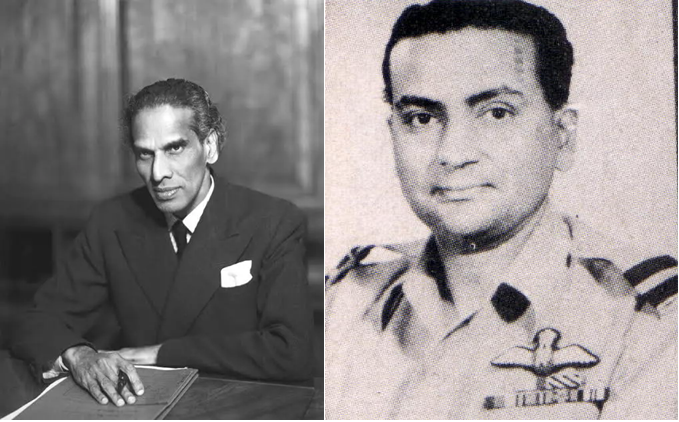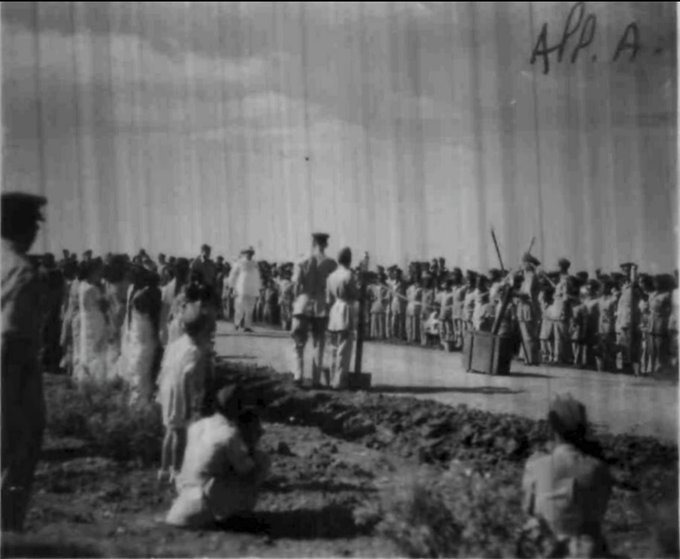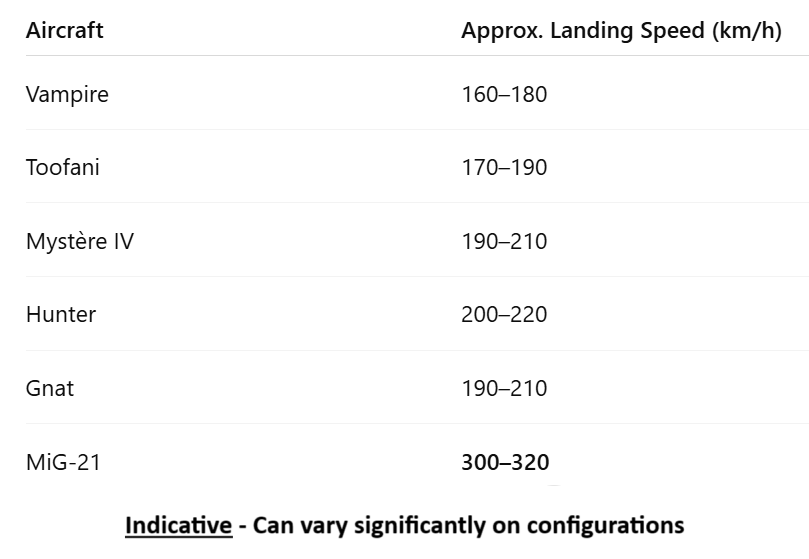Btwn 1954-64, the night skies of Delhi & Bombay were protected by a unique @IAF_MCC fighter aircraft - DeHavilland Vampire NF54 (aka NF10 in @RoyalAirForce). This is the fascinating short-lived journey of the only exclusive night-fighter aircraft in the IAF. #IAFHistory (1/24) 

Designed as a cheap export ac on the back of an order from the Egyptian Air Force, the NF10 used the wings & tail unit of the Vampire Day-fighter and side-by-side seating of the extant night-fighter Mosquito NF36 – Navigator/ Radar Operator on the right and pilot on the left. 2/ 

Destiny had other plans, Egypt could not come good on the order due to an embargo and RAF stepped in as the main buyer. RAF was separately looking to replace its Mosquito NF36, but it's choice replacement – Gloster Meteor NF11 was delayed. Vampire NF10 would be the stop gap! 3/ 

The NF10 had an endurance of 2 hours at 30,000 ft, a Goblin-3 engine, a fuel system suitable for aerobatics, AI Mk10 Radar with IFF Mk3, and 4 20-mm Hispano Guns. A Span of 38 ft, Max wt of 13,100 lb, max speed of 538 mph, and range of 1,220 miles with drop tanks. 4/
It had its limitations too – the lack of ejection seats on a single-engine left aircrew uncomfortable. Electricals were rudimentary for a night role. Mk10 AI radar was obsolete but could work well with Ground Control Interception with a max/min range of 6 miles/300 feet. 5/ 

In all, 90 production ac were mfged. RAF took 76, & Italian AF took 14. Three RAF sqns served with these ac btwn 1951 and 54, at which point they upgraded, and India stepped in to buy 30 of these in two lots (18 in 1954 & 12 in 1957). The export variant was called NF54. 6/ 

IAF’s rational to acquire the NFs remains unclear. Three plausible reasons – a) PAF bomber threat from Halifax & newly acquired B-57s, b) IAF’s buildup of the AD network focussed on point defence of major cities & c) Familiarity with Vampire (Day-fighter) - mainstay & HAL mfgd 7/ 

PAF had acquired the Halifax in 1947 and added 6 more later. While outdated, they did participate in the Kashmir War, dropping supplies at NIGHT and PAF’s attempt to use it at as night bomber/ paradrop might have made IAF look for counter measures. 8/ 

Secondly, in 1949 IAF had ordered 5 T-13/14/15 Radars from Marconi to be used as Sector Ops Centres for Ground Control interception. 1954 is when the first was setup at Delhi (11 SU) and not surprisingly, the first Night Fighter Sqn was based at Palam (10 Sqn). 9/ 

IAF crews left for UK in Dec 1953 to convert to the NFs. 10 Sqn was selected, moved from Halwara to Palam in Dec 53. In June 54 S/L David Bouche, returned from UK (RAF Rushton & Leeming) & took over as the first CO of 10 Sqn in its night-fighter role as the first ac arrived. 10/ 

NF required the pilot to do instrument flying & a Nav/ Radar operator who did the interception requiring great skill & dexterity. Very close co-operation was needed with the ground controller to put them in a favorable position. The best in IAF were selected for the job. 11/ 

The role of the Navigator was critical. He was expected to navigate at night, operate the onboard radar, communicate with the ground controller & guide the aircraft for gun firing. It is no wonder that Navs in NF Sqn’s were made officiating COs/Flt Cdrs. 12/ 

IAF operated only 10 Sqn on the NFs till Jan 58, when 37 Sqn was formed with a nucleus of the crew from 10 Sqn at Palam itself. In 1957-58, IAF had taken delivery of a further 12 NFs from RAF and these were used to raise 37 Sqn. 13/ 

37 Sqn operated the NFs for only 5 years (58-62) but had an eventful time. In 58 it suffered two fatal accidents, the only in the NF fleet ever. Moved to Pune in Feb 60 to defend Bombay and took part in the 61 Goa liberation ops during this period 14/ 

In May 58, A NF of 37 Sqn caught fire over Delhi and crashed into Safdarjung Airport killing both the pilot & Nav. The consequent fire gutted 12 aircraft of the Flying Club and killed four mechanics. Later in Aug, another NF went missing and was never found, presumed crashed. 15/ 

37 Sqn had a limited role in the 61 Goa ops. A recce at Dabolim at 300 ft AGL where Ack-ack opened up on them. Later that night same at Daman & finally scrambled to chase of Portuguese Super Connie that took off from Dabolim, & hugging the deck went to Karachi. 16/ 

Story of NF fleet is incomplete without the “Nosey Dakota”- HJ879. Acquired in 1958 & flown from the UK after modification with radome fitted on its nose, housing radar providing search/ homing facility to airborne targets. The purpose was to use this to train Navs of 10 Sqn. 17/ 

For the bulk of its active period, the aircraft was singularly flown by HMPS Pannu. The Dakota trained the navigators to get into position (Such that the pilot can use the Gun on target) below at the 6 o'clock of the Harvard that flew as a target. 18/ 

It was a Dakota Mk IV with two stage superchargers & had the superchargers active - unlike most MK IV which had the second stage blanked off. The aircraft was not easy to fly with reduced visibility due to the bulbous nose. Later it became part of 43 Sqn as a normal Dakota. 19/ 

AVM KK Jain, was a young Fighter Controller with 11 SU at Najafgarh operating the T-14/15 Marconi Radar in 1961 & controlling the NFs of 10 Sqn and remembers an exercise with Liberators of 6 Sqn & the NFs as a sight to be seen. 20/ 

In Oct 62, 37 Sqn converted to Hunter ac and in April 64, 10 Sqn was numberplated bringing an end to the service of NFs in IAF. The decision possibly driven by poor serviceability of the fleet & acquisition of the MiG-21 which reduced the need for separate day/night fighters. 21/ 

The MiG-21s had to wait until 1971 to be effective in a night role. The decision to wind-down NFs left IAF vulnerable in the 1965 war where incidentally the 8-pass Charlie (B-57), in a solo raid destroyed a MiG-21 on the ground at 2200 in the night. An ironical twist. 22/ 

In the only surviving and befitting picture dedicated to the crew of the IAF Nightriders - seen here is SR Powar as the CO with the entire 10 sqn in attendance. Likely taken between 1957 to 59. 23/ 

58 years since winding down, the lone surviving Vampire NF54, ID606 still stands vigil over Delhi skies at the Air Force Museum at Palam. (24/24) 

@threadreaderapp unroll
• • •
Missing some Tweet in this thread? You can try to
force a refresh






















